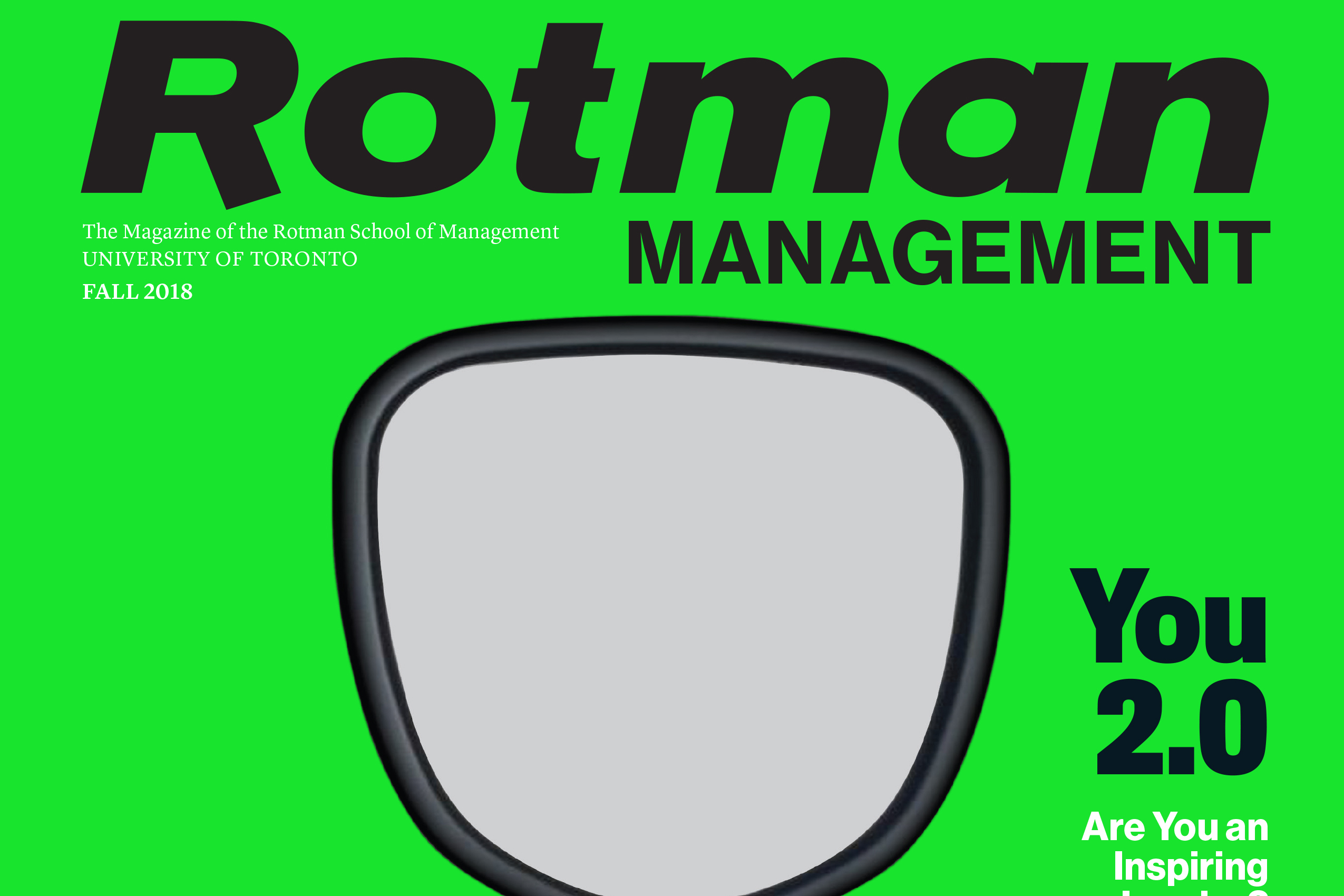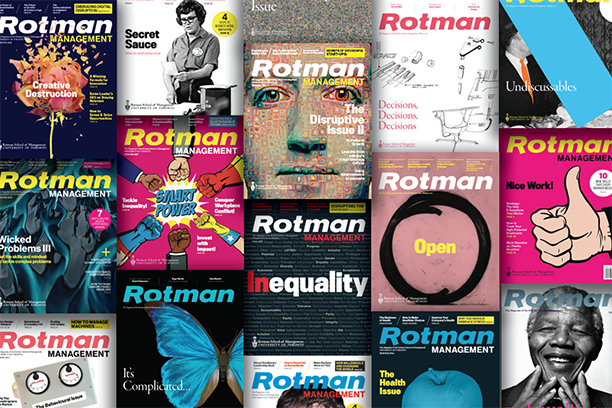You 2.0 (Fall 2018)
What if you could raise your level of self-awareness exponentially? Learn to ask better questions and form better problem statements? Help the people around you build up their resilience? And banish bias from your organization? In this issue, we examine a variety of ways to take yourself to the next level as a leader and colleague — and make the most of your potential.
Preview This Issue

Purchase This Issue
Due to their timeless themes, Rotman Management issues remain relevant long after publication.

Editor's Letter
IF YOU OPENED THIS MAGAZINE feeling confident about your leadership skills, consider this: According to McKinsey’s study of 80,000 leaders, 77 per cent believe they do a good job of engaging their people and fostering productivity; yet 82 per cent of employees disagree. Worse yet, more than one third of employees — 35 per cent (!) — would gladly forgo a pay raise to see their boss fired....

Subscribe Today
Rotman Management magazine is your destination for exclusive thought leader interviews, breakthrough research from leading academics, and innovative new ideas from top management thinkers.
Feature Articles From this Issue
Feature articles from Rotman Management magazine can be purchased individually as PDF documents.
Click on any title to proceed to the purchase page at hbr.org.
 |
|

|
|

|
|

|
- (FREE) Meet Canada’s Most Powerful Women
Compiled by Karen Christensen
A total of 16 alumni of the Rotman School of Management were named to WXN’s Most Powerful Women in Canada ranking. We are pleased to introduce you to seven of them.
|

|
- (FREE) Navigating the Innovation Ecosystem
by Ajay Agrawal and Alberto Galasso
The authors argue that a thriving environment for innovation contains eight characteristics, and that assessing them properly sets the stage for a start-up to flourish. After describing the eight characteristics, they use them to compare Toronto with Silicon Valley as a location for start-ups to thrive. In the end, they show that ignoring the eight factors may lead founders to pick the wrong location, resulting in difficulty attracting the necessary funding, talent, suppliers, partnerships and customers.
|

|
- Data Analytics: From Bias to Better Decisions
by Megan MacGarvie and Kristina McElheran
Even with impressively large data sets and the best analytics tools, we are still vulnerable to a range of decision-making pitfalls, especially when information overload leads us to take shortcuts in reasoning. As a result, in some instances, data and analytics actually make matters worse. The authors show that leaders need to be aware of three common data-related decision making pitfalls: the confirmation trap, the over-confidence trap and the over-fitting trap. They describe each in detail and provide practical tips for overcoming each type of bias.
|

|
- The Mindful Leader
by Rasmus Hougaard and Jacqueline Carter
Leadership pioneer Peter Drucker once said, “You cannot manage other people unless you manage yourself first.” The authors agree, and they argue that more specifically, leadership starts with your mind. They explain four principles that every leader should know about their mind: You do not control your mind; you are not rational; your mind creates your reality; and you are not your thoughts. The then show how embracing these principles and being mindful leads you on the road to self-awareness, resulting in happiness and strong leadership.
|

|
- So, You Want to Be a CEO?
by David R. Beatty
At some point in their careers, most—if not all—executives aspire to become the CEO of their organization. And why not? These individuals tend to be highly ambitious. However, as with most things in life, aspiration is one thing, and execution is another. The author, who has worked closely with CEOs for 30 years as a board director, describes what it takes to be a CEO today. He shows that any would-be CEO must develop four particular ‘directional’ skills: upwards, downwards, outwards and outside-in, which enable him/her to be a Chief Relationship Officer, Chief Strategic Officer, Chief Communications Officer and Chief External Officer for the organization.
|

|
- Are You an Inspiring Leader?
by Mark Horwitch and Meredith Whipple Callahan
The power of a company with leaders who inspire at every level up and down the organization is hard to overstate. These are the companies that consistently pull off innovative or heroic feats in business because so many of the people who work there are motivated to make them happen. The authors—consultants at Bain and Co.—describe their five-year research study, which uncovered 33 distinct and tangible attributes that are statistically significant in creating inspiration in others. The good news: Having just four of these attributes is sufficient to make someone highly inspiring.
|

|
- The Strategy Palette: Approaches to Strategy for a Complex World
by Martin Reeves
The author, a senior partner with the Boston Consulting Group, set out to answer the question, ‘Is strategy still relevant?’ He found that not only is it relevant, but doing things in a differentiated way is more important than ever. The trick is to figure out three characteristics of the environment you operate within: unpredictability, malleability and harshness. Ranking a business on these factors leads to one of five strategic approaches: classic strategy; adaptive strategy; the visionary approach; the shaping approach; or strategic renewal. In the end he shows that you can generate value by engaging with each opportunity with the right framing and awareness.
|

|
- A Theory of Workplace Anxiety
by Bonnie Cheng and Julie McCarthy
Research indicates that 40 per cent of Americans report feeling anxious during the work day. On the one hand, anxiety can conjure up distressing thoughts and have detrimental effects on performance; but on the other, anxiety can drive actions and have positive effects on performance. The authors set out to create a theory of workplace anxiety that reconciles the positive and negative effects of anxiety, covering dispositional anxiety, situational anxiety, job characteristics and more. Their findings have important implications for personnel selection practices, promotions, goal-setting initiatives and work-life integration programs.
|

|
- How to Disrupt Bias—and Drive Value
by Sylvia Ann Hewlett, Ripa Rashid and Laura Sherbin
Anti-bias training is extremely popular in Silicon Valley, where tech titans like Facebook and Google mandate it, but a similar trend is on the rise among Fortune 500 corporations. To help root out bias, the authors developed ACE, a framework that codifies employee potential and can be used to analyze bias in assessments of potential. They describe the six elements of the ACE model and go on to provide a three-part strategy for uprooting bias in every organization.
|
 |
- Thought Leader Interview: Daniel Pink
by Karen Christensen
Best-selling author and regular on the Thinkers50 ranking of the world’s most influential management thinkers, Daniel Pink discusses why timing is everything. He describes the bi-modal pattern that we all experience each day; the effects of these ‘peaks’ and ‘troughs’ on an organization; and why beginnings, mid-points and ends are so important to us. He then provides some practical advice for leaders that incorporates these lessons.
|